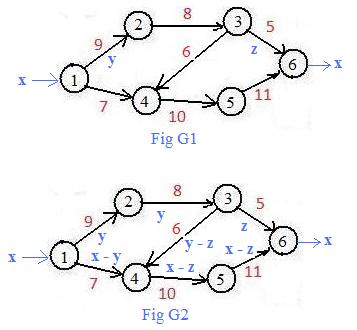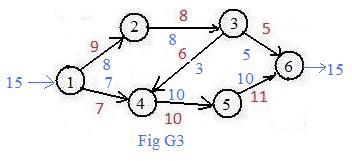Return to main page
Additional Material

Algebraic Method for Finding Maxflow through DiGraph in Fig G
G=G1;
Let x = Maxflow. Then x enters node 1 and exits node 6.
Let y = flow through link 1→2 and let z be the flow through link 3→6. Then flow through link 1→4 must be x - y and the flow through link 5→6 must be x - z.
The flow through link 2→3 must equal the flow through link 1→2, that is y and the flow through link 4→5 must equal the flow through link 5→6, that is x - z.
The inflow y into node 3 must equal the total outflow, so the flow through link 3→4 must be y - z for this to be true. Notice then that the total inflow into node 4 does equal the outflow x - z.
The flow through link 2→3 cannot be more than the capacity of that link. Therefore,
(A) y ≤ 8
Likewise, the flow through link 1→4 cannot be more than its capacity. This means that x - y ≤ 7 which is equivalent to
(B) x ≤ y + 7
From (A) and (B) follows (C):
(C) x ≤ 15
The flow through link 3→6 cannot be more than its capacity. This means that
(D) z ≤ 5
 Replace the weak inequalities in (A),(C) and (D) by equalities
Replace the weak inequalities in (A),(C) and (D) by equalities
x = 15,
y = 8,
z = 5,
Find the flow through each link by substituting these values for x,y,z in the corresponding expressions in Fig G2 to get Fig G3. The fact that
total inflow = total outflow
is true at every node, the flow through each link is not more than the capacity, together with (C) means that
x = 15
is the maximum flow through the graph.
 Replace the weak inequalities in (A),(C) and (D) by equalities
Replace the weak inequalities in (A),(C) and (D) by equalities

 Replace the weak inequalities in (A),(C) and (D) by equalities
Replace the weak inequalities in (A),(C) and (D) by equalities